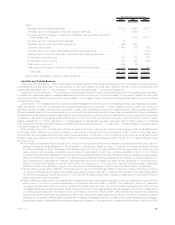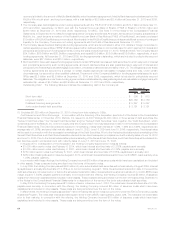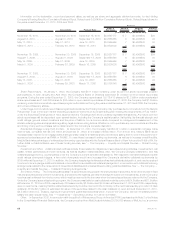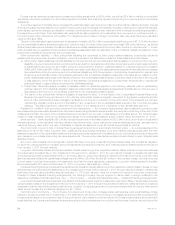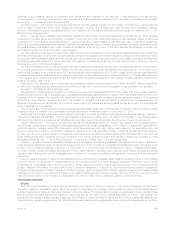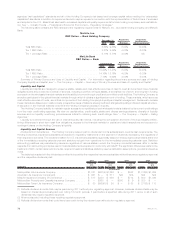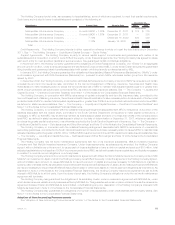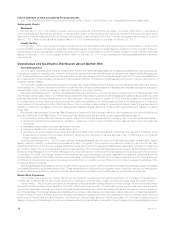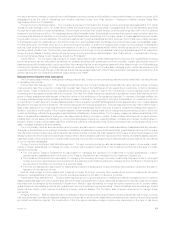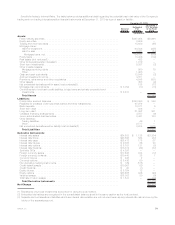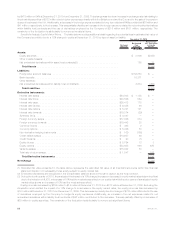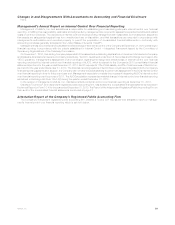MetLife 2010 Annual Report Download - page 76
Download and view the complete annual report
Please find page 76 of the 2010 MetLife annual report below. You can navigate through the pages in the report by either clicking on the pages listed below, or by using the keyword search tool below to find specific information within the annual report.
(4) Includes securities transferred to the Holding Company of $399 million.
(5) Consists of shares of RGA stock distributed by MLIC to the Holding Company as an in-kind dividend of $1,318 million.
(6) Reflects dividends permitted to be paid and the respective dividends paid since the Acquisition Date. See Note 2 to the Notes to the
Consolidated Financial Statements.
(7) Includes shares of an affiliate distributed to the Holding Company as an in-kind dividend of $475 million.
(8) Includes shares of an affiliate distributed to the Holding Company as an in-kind dividend of $164 million.
In addition to the amounts presented in the table above, for the years ended December 31, 2010, 2009 and 2008, cash dividends in the
aggregate amount of $0, $215 million and $235 million, respectively, were paid to the Holding Company.
The dividend capacity of non-U.S. operations is subject to similar restrictions established by the local regulators. The non-U.S. regulatory
regimes also commonly limit the dividend payments to the parent to a portion of the prior year’s statutory income, as determined by the local
accounting principles. The regulators of the non-U.S. operations, including the Japan branch of American Life, may also limit or not permit
profit repatriations or other transfers of funds to the U.S. if such transfers would be detrimental to the solvency or financial strength of the
operations of the non-U.S. operations, or for other reasons. Most of the non-U.S. subsidiaries are second tier subsidiaries and are not directly
owned by the Holding Company. The capital and rating considerations applicable to the first tier subsidiaries may also impact the dividend
flow into the Holding Company.
The Company’s management actively manages its target and excess capital levels and dividend flows on a pro-active basis and forecasts
local capital positions as part of the financial planning cycle. The dividend capacity of certain U.S. and non-U.S. subsidiaries is also subject to
business targets in excess of the minimum capital necessary to maintain the desired rating or level of financial strength in the relevant market.
Management of the Holding Company cannot provide assurances that the Holding Company’s subsidiaries will have statutory earnings to
support payment of dividends to the Holding Company in an amount sufficient to fund its cash requirements and pay cash dividends and that
the applicable regulators will not disapprove any dividends that such subsidiaries must submit for approval. See Note 18 of the Notes to the
Consolidated Financial Statements.
Liquid Assets. An integral part of the Holding Company’s liquidity management is the amount of liquid assets it holds. Liquid assets
include cash, cash equivalents, short-term investments and publicly-traded securities, excluding: (i) cash collateral received under the
Company’s securities lending program that has been reinvested in cash, cash equivalents, short-term investments and publicly-traded
securities; and (ii) cash collateral received from counterparties in connection with derivative instruments. At December 31, 2010 and 2009,
the Holding Company had $2.8 billion and $3.8 billion, respectively, in liquid assets. In addition, the Holding Company has pledged collateral
and has had collateral pledged to it, and may be required from time to time to pledge additional collateral or be entitled to have additional
collateral pledged to it. At December 31, 2010 and 2009, the Holding Company had pledged $362 million and $289 million, respectively, of
liquid assets under collateral support agreements.
Shelf Registration. In November 2010, the Holding Company filed a shelf registration statement (the “2010 Shelf Registration State-
ment”) with the U.S. Securities and Exchange Commission (“SEC”), which was automatically effective upon filing, in accordance with SEC
rules. SEC rules also allow for pay-as-you-go fees and the ability to add securities by filing automatically effective amendments for
companies, such as the Holding Company, which qualify as “Well-Known Seasoned Issuers.” The 2010 Shelf Registration Statement
registered an unlimited amount of debt and equity securities and replaces the shelf registration statement that the Holding Company filed in
November 2007, which expired in the fourth quarter of 2010. The terms of any offering will be established at the time of the offering.
Global Funding Sources. Liquidity is also provided by a variety of short-term instruments, including commercial paper. Capital is
provided by a variety of instruments, including medium- and long-term debt, junior subordinated debt securities, collateral financing
arrangements, capital securities and stockholders’ equity. The diversity of the Holding Company’s funding sources enhances funding
flexibility, limits dependence on any one source of funds and generally lowers the cost of funds. Other sources of the Holding Company’s
liquidity include programs for short-and long-term borrowing, as needed.
We continuously monitor and adjust our liquidity and capital plans for the Holding Company and its subsidiaries in light of changing
requirements and market conditions.
Long-term Debt. The following table summarizes the outstanding long-term debt of the Holding Company at:
2010 2009
December 31,
(In millions)
Long-termdebt—unaffiliated ............................................ $16,258 $10,458
Long-termdebt—affiliated.............................................. $ 665(1) $ 500
Collateralfinancingarrangements.......................................... $ 2,797 $ 2,797
Juniorsubordinateddebtsecurities......................................... $ 1,748 $ 1,748
(1) Includes $165 million of affiliated senior notes associated with bonds held by ALICO.
Short-term Debt. MetLife, Inc. maintains a commercial paper program, proceeds of which can be used to finance the general liquidity
needs of MetLife, Inc. and its subsidiaries. The Holding Company had no short-term debt outstanding at both December 31, 2010 and 2009.
There was no short-term debt activity in 2010. During the years ended December 31, 2009 and 2008, the weighted average interest rate on
short-term debt, comprised only of commercial paper, was 1.25% and 2.5%, respectively. During the year ended December 31, 2009, the
average daily balance on short-term debt was $5 million, and the average days outstanding was 6 days.
Debt Issuances and Other Borrowings. For information on debt issuances and other borrowings entered into by the Holding Company,
see “— The Company — Liquidity and Capital Sources — Debt Issuances and Other Borrowings.”
73MetLife, Inc.


